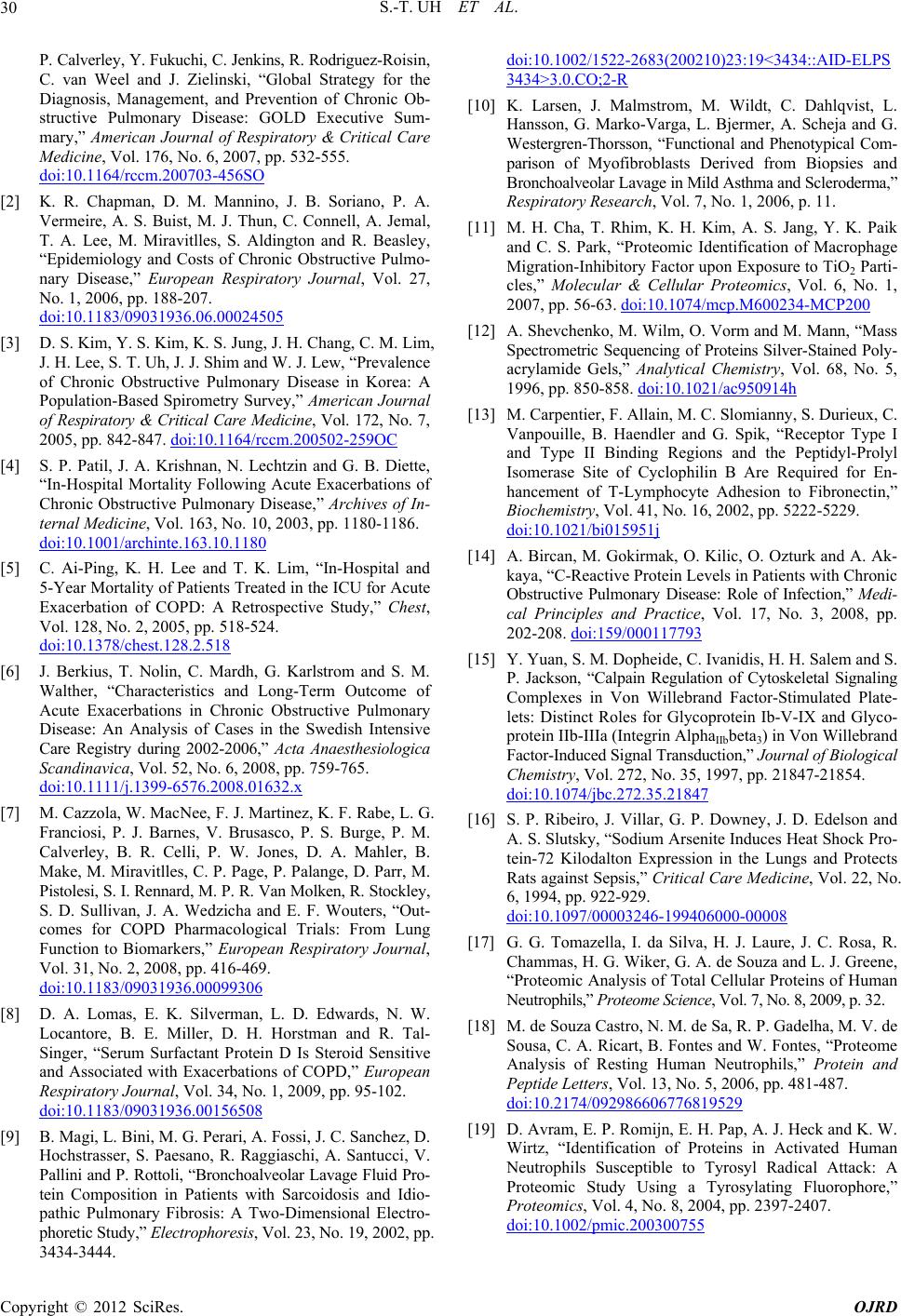
S.-T. UH ET AL.
30
P. Calverley, Y. Fukuchi, C. Jenkins, R. Rodriguez-Roisin,
C. van Weel and J. Zielinski, “Global Strategy for the
Diagnosis, Management, and Prevention of Chronic Ob-
structive Pulmonary Disease: GOLD Executive Sum-
mary,” American Journal of Respiratory & Critical Care
Medicine, Vol. 176, No. 6, 2007, pp. 532-555.
doi:10.1164/rccm.200703-456SO
[2] K. R. Chapman, D. M. Mannino, J. B. Soriano, P. A.
Vermeire, A. S. Buist, M. J. Thun, C. Connell, A. Jemal,
T. A. Lee, M. Miravitlles, S. Aldington and R. Beasley,
“Epidemiology and Costs of Chronic Obstructive Pulmo-
nary Disease,” European Respiratory Journal, Vol. 27,
No. 1, 2006, pp. 188-207.
doi:10.1183/09031936.06.00024505
[3] D. S. Kim, Y. S. Kim, K. S. Jung, J. H. Chang, C. M. Lim,
J. H. Lee, S. T. Uh, J. J. Shim and W. J. Lew, “Prevalence
of Chronic Obstructive Pulmonary Disease in Korea: A
Population-Based Spirometry Survey,” American Journal
of Respiratory & Critical Care Medicine, Vol. 172, No. 7,
2005, pp. 842-847. doi:10.1164/rccm.200502-259OC
[4] S. P. Patil, J. A. Krishnan, N. Lechtzin and G. B. Diette,
“In-Hospital Mortality Following Acute Exacerbations of
Chronic Obstructive Pulmonary Disease,” Archives of In-
ternal Medicine, Vol. 163, No. 10, 2003, pp. 1180-1186.
doi:10.1001/archinte.163.10.1180
[5] C. Ai-Ping, K. H. Lee and T. K. Lim, “In-Hospital and
5-Year Mortality of Patients Treated in the ICU for Acute
Exacerbation of COPD: A Retrospective Study,” Chest,
Vol. 128, No. 2, 2005, pp. 518-524.
doi:10.1378/chest.128.2.518
[6] J. Berkius, T. Nolin, C. Mardh, G. Karlstrom and S. M.
Walther, “Characteristics and Long-Term Outcome of
Acute Exacerbations in Chronic Obstructive Pulmonary
Disease: An Analysis of Cases in the Swedish Intensive
Care Registry during 2002-2006,” Acta Anaesthesiologica
Scandinavica, Vol. 52, No. 6, 2008, pp. 759-765.
doi:10.1111/j.1399-6576.2008.01632.x
[7] M. Cazzola, W. MacNee, F. J. Martinez, K. F. Rabe, L. G.
Franciosi, P. J. Barnes, V. Brusasco, P. S. Burge, P. M.
Calverley, B. R. Celli, P. W. Jones, D. A. Mahler, B.
Make, M. Miravitlles, C. P. Page, P. Palange, D. Parr, M.
Pistolesi, S. I. Rennard, M. P. R. Van Molken, R. Stockley,
S. D. Sullivan, J. A. Wedzicha and E. F. Wouters, “Out-
comes for COPD Pharmacological Trials: From Lung
Function to Biomarkers,” European Respiratory Journal,
Vol. 31, No. 2, 2008, pp. 416-469.
doi:10.1183/09031936.00099306
[8] D. A. Lomas, E. K. Silverman, L. D. Edwards, N. W.
Locantore, B. E. Miller, D. H. Horstman and R. Tal-
Singer, “Serum Surfactant Protein D Is Steroid Sensitive
and Associated with Exacerbations of COPD,” European
Respiratory Journal, Vol. 34, No. 1, 2009, pp. 95-102.
doi:10.1183/09031936.00156508
[9] B. Magi, L. Bini, M. G. Perari, A. Fossi, J. C. Sanchez, D.
Hochstrasser, S. Paesano, R. Raggiaschi, A. Santucci, V.
Pallini and P. Rottoli, “Bronchoalveolar Lavage Fluid Pro-
tein Composition in Patients with Sarcoidosis and Idio-
pathic Pulmonary Fibrosis: A Two-Dimensional Electro-
phoretic Study,” Electrophoresis, Vol. 23, No. 19, 2002, pp.
3434-3444.
doi:10.1002/1522-2683(200210)23:19<3434::AID-ELPS
3434>3.0.CO;2-R
[10] K. Larsen, J. Malmstrom, M. Wildt, C. Dahlqvist, L.
Hansson, G. Marko-Varga, L. Bjermer, A. Scheja and G.
Westergren-Thorsson, “Functional and Phenotypical Com-
parison of Myofibroblasts Derived from Biopsies and
Bronchoalveolar Lavage in Mild Asthma and Scleroderma,”
Respiratory Research, Vol. 7, No. 1, 2006, p. 11.
[11] M. H. Cha, T. Rhim, K. H. Kim, A. S. Jang, Y. K. Paik
and C. S. Park, “Proteomic Identification of Macrophage
Migration-Inhibitory Factor upon Exposure to TiO2 Parti-
cles,” Molecular & Cellular Proteomics, Vol. 6, No. 1,
2007, pp. 56-63. doi:10.1074/mcp.M600234-MCP200
[12] A. Shevchenko, M. Wilm, O. Vorm and M. Mann, “Mass
Spectrometric Sequencing of Proteins Silver-Stained Poly-
acrylamide Gels,” Analytical Chemistry, Vol. 68, No. 5,
1996, pp. 850-858. doi:10.1021/ac950914h
[13] M. Carpentier, F. Allain, M. C. Slomianny, S. Durieux, C.
Vanpouille, B. Haendler and G. Spik, “Receptor Type I
and Type II Binding Regions and the Peptidyl-Prolyl
Isomerase Site of Cyclophilin B Are Required for En-
hancement of T-Lymphocyte Adhesion to Fibronectin,”
Biochemistry, Vol. 41, No. 16, 2002, pp. 5222-5229.
doi:10.1021/bi015951j
[14] A. Bircan, M. Gokirmak, O. Kilic, O. Ozturk and A. Ak-
kaya, “C-Reactive Protein Levels in Patients with Chronic
Obstructive Pulmonary Disease: Role of Infection,” Medi-
cal Principles and Practice, Vol. 17, No. 3, 2008, pp.
202-208. doi:159/000117793
[15] Y. Yuan, S. M. Dopheide, C. Ivanidis, H. H. Salem and S.
P. Jackson, “Calpain Regulation of Cytoskeletal Signaling
Complexes in Von Willebrand Factor-Stimulated Plate-
lets: Distinct Roles for Glycoprotein Ib-V-IX and Glyco-
protein IIb-IIIa (Integrin AlphaIIbbeta3) in Von Willebrand
Factor-Induced Signal Transduction,” Journal of Biological
Chemistry, Vol. 272, No. 35, 1997, pp. 21847-21854.
doi:10.1074/jbc.272.35.21847
[16] S. P. Ribeiro, J. Villar, G. P. Downey, J. D. Edelson and
A. S. Slutsky, “Sodium Arsenite Induces Heat Shock Pro-
tein-72 Kilodalton Expression in the Lungs and Protects
Rats against Sepsis,” Critical Care Medicine, Vol. 22, No.
6, 1994, pp. 922-929.
doi:10.1097/00003246-199406000-00008
[17] G. G. Tomazella, I. da Silva, H. J. Laure, J. C. Rosa, R.
Chammas, H. G. Wiker, G. A. de Souza and L. J. Greene,
“Proteomic Analysis of Total Cellular Proteins of Human
Neutrophils,” Proteome Science, Vol. 7, No. 8, 2009, p. 32.
[18] M. de Souza Castro, N. M. de Sa, R. P. Gadelha, M. V. de
Sousa, C. A. Ricart, B. Fontes and W. Fontes, “Proteome
Analysis of Resting Human Neutrophils,” Protein and
Peptide Letters, Vol. 13, No. 5, 2006, pp. 481-487.
doi:10.2174/092986606776819529
[19] D. Avram, E. P. Romijn, E. H. Pap, A. J. Heck and K. W.
Wirtz, “Identification of Proteins in Activated Human
Neutrophils Susceptible to Tyrosyl Radical Attack: A
Proteomic Study Using a Tyrosylating Fluorophore,”
Proteomics, Vol. 4, No. 8, 2004, pp. 2397-2407.
doi:10.1002/pmic.200300755
Copyright © 2012 SciRes. OJRD